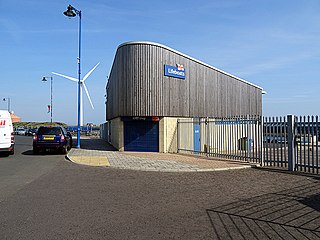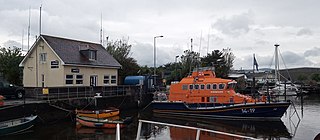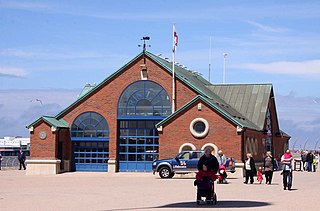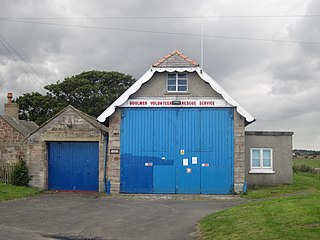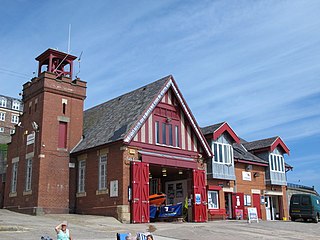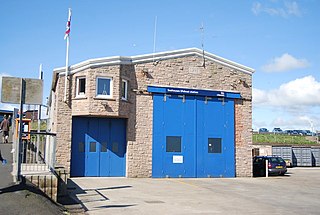History
Before there was a Drogheda lifeboat, Robert Kirkpatrick Thompson, Chief Officer of H.M. Coastguard at Clogherhead, received the RNLI Gold Medal in 1839, for the rescue of the Master and three crew from the schooner Minerva, wrecked on the North Bar at Drogheda on 31 March 1839. [2]
The first Drogheda lifeboat was a 30-foot Self-righting 'pulling and sailing' (P&S) lifeboat, one with both oars and sail, of 'Mr. Peake's design', built by Forrestt of Limehouse, London, at a cost of £155. A carriage was supplied from Ransomes & Sons of Ipswich, and a boathouse was constructed at Baltray, near the mouth of the River Boyne, by the Drogheda Harbour Commissioners. Both lifeboat and carriage were transport to Drogheda free of charge by the British and Irish Steam Packet Company. The station opened in 1856. John McNamara was appointed Honorary Secretary. [3]
On 7 February 1862, the Baltray lifeboat was launched to the aid of the brig Minerva on Workington, aground on the South Bull. Holed and taking on water, the crew of five and the Captain were rescued. [4]
A 28-foot lifeboat was placed at Baltray in 1862. It was named Rescue, and had served at St Sampson in Guernsey from 1857. It would be launched to the aid of the schooner Mary Anne, driven ashore on 2 February 1863, and rescued the crew of five. [5]
In 1867, funds were appropriated from the legacy of Miss Maria Irlam of Dibbinsdale, Bromborough, and the lifeboat was renamed Old George Irlam of Liverpool. [6] Two later lifeboats also carried the name Old George Irlam of Liverpool. [1]
On passage from Newport, Monmouthshire to Dublin, the brig Manly was driven onto the sands in a severe gale on 27 September 1871. Baltray lifeboat launched, but could not reach the vessel in the conditions. Six of the crew of the Manly were lost. One person survived. He had been washed away from the vessel, but had a lifebouy, and was rescued from the heavy surf by Miss Jane Campbell, assisted by a Mrs Fox. Jane Campbell was awarded the RNLI Silver Medal, with Mrs Fox receiving 'The Thanks of the Institution inscribed on Vellum'. [2]
Following the loss of the Manly, it was decided to open a No.2 station at Drogheda in 1872, located on the south side of the River Boyne at Mornington, County Meath. [1]
On 25 September 1876, Old George Irlam of Liverpool was launched to the aid of the brigantine Maxim, on passage from Liverpool to Saint John's, Newfoundland. Driven ashore 2 miles (3.2 km) north of the River Boyne bar, the eight crewmen were rescued. [7] [8]
Between 1879 and 1899, the Baltray lifeboat was launched only eight times, with no lives saved. In 1899, it was decided to close one of the stations on the River Boyne, and place a lifeboat further up the coast at Clogherhead, a fishing port, with no shortage of crew. Mornington lifeboat station remained in service (until 1926), and the Baltray Lifeboat Station was closed. [3]
The lifeboat on station at the time, Charles Whitton (ON 334), would serve at Mornington from 1901 to 1902, and become the Port Isaac lifeboat from 1905 to 1927. The station building was handed over to Drogheda Corporation for temporary use as an Isolation hospital in 1900. All that remains today is evidence of the launchway. [1] [3]


